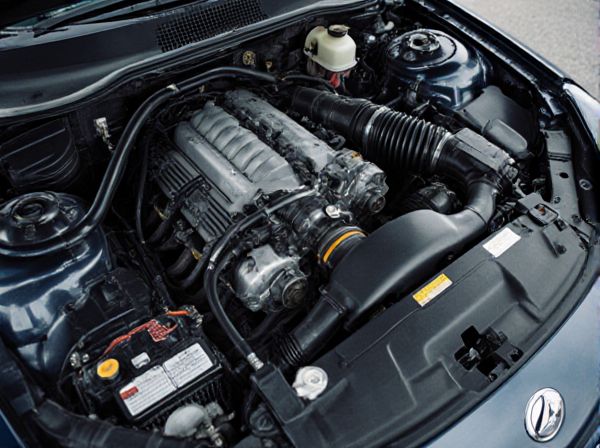
Photo illustration: Sequential Fuel Injection vs Batch Fuel Injection
Sequential fuel injection delivers fuel to each cylinder individually just before the intake valve opens, enhancing combustion efficiency and reducing emissions. Batch fuel injection sprays fuel into multiple cylinders simultaneously, often leading to less precise fuel delivery and lower fuel economy. Your choice between these systems impacts engine performance, fuel efficiency, and emissions control.
Table of Comparison
| Feature | Sequential Fuel Injection (SFI) | Batch Fuel Injection (BFI) |
|---|---|---|
| Injection Timing | Individual injector fires sequentially per cylinder | Multiple injectors fire simultaneously in batches |
| Fuel Efficiency | Higher, due to precise fuel metering | Lower, due to less precise timing |
| Engine Performance | Improved throttle response and smoother idle | Less refined, possible rough idle |
| Emissions | Lower hydrocarbon and NOx emissions | Higher emissions due to incomplete combustion |
| System Complexity | More complex, requires camshaft position sensor | Simpler design, easier maintenance |
| Cost | Higher initial cost due to advanced electronics | Lower cost, simpler components |
Introduction to Fuel Injection Systems
Sequential fuel injection delivers fuel to each cylinder individually and precisely timed to intake stroke, improving combustion efficiency and reducing emissions. Batch fuel injection sprays fuel into multiple cylinders simultaneously in groups, typically during the intake valve opening phase, which offers simpler control but less precise fuel delivery. Both systems optimize fuel atomization and engine performance but differ in timing accuracy and emission control effectiveness.
What is Sequential Fuel Injection?
Sequential Fuel Injection delivers fuel to each cylinder individually and precisely timed to the intake valve opening, enhancing combustion efficiency and reducing emissions. This system uses crankshaft and camshaft position sensors to synchronize fuel delivery with each cylinder's intake stroke. Compared to batch fuel injection, it offers improved throttle response, better fuel economy, and lower exhaust pollutants by optimizing the air-fuel mixture for each cylinder.
Understanding Batch Fuel Injection
Batch fuel injection delivers fuel to multiple cylinders simultaneously in groups rather than individually, resulting in simpler engine control systems and reduced manufacturing costs. While less precise than sequential fuel injection, batch injection ensures adequate fuel delivery during varying engine loads and speeds by injecting fuel into intake ports in sets or batches. Its less complex operation makes it common in older or less performance-oriented vehicles where cost and reliability take precedence over optimal fuel efficiency and emissions control.
Key Differences Between Sequential and Batch Injection
Sequential fuel injection delivers precise fuel directly to each cylinder's intake valve just before the intake stroke, enhancing combustion efficiency and reducing emissions. Batch fuel injection sprays fuel into multiple cylinders simultaneously, which can lead to less accurate fuel delivery and increased fuel consumption. Key differences include injection timing, with sequential offering cylinder-specific timing, whereas batch uses group timing, impacting performance and fuel economy.
Performance Comparison: Sequential vs. Batch
Sequential fuel injection delivers fuel directly to each cylinder's intake port in precise timing with the intake valve opening, enhancing combustion efficiency and improving throttle response. Batch fuel injection sprays fuel into multiple cylinders simultaneously without individual timing control, leading to less precise fuel delivery and potentially higher emissions. Performance-wise, sequential injection offers better fuel economy, smoother engine operation, and reduced exhaust emissions compared to batch injection systems.
Fuel Efficiency Analysis
Sequential fuel injection delivers fuel directly into each cylinder just before the intake valve opens, resulting in precise fuel metering that enhances combustion efficiency and reduces fuel consumption. Batch fuel injection injects fuel into groups of cylinders simultaneously, which can lead to less accurate fuel delivery timing and increased fuel wastage under varying engine loads. Studies indicate sequential systems improve fuel efficiency by up to 10% compared to batch injection due to optimized air-fuel mixing and reduced incomplete combustion.
Emissions and Environmental Impact
Sequential fuel injection delivers precise fuel amounts directly to each cylinder at the optimal time, resulting in more complete combustion and significantly lower emissions of unburned hydrocarbons and carbon monoxide compared to batch fuel injection. Batch fuel injection sprays fuel into multiple cylinders simultaneously, leading to less efficient combustion and higher levels of pollutants such as nitrogen oxides (NOx) and particulate matter. Improved combustion control in sequential systems reduces environmental impact by enhancing fuel efficiency and minimizing harmful exhaust emissions.
Cost and Maintenance Considerations
Sequential fuel injection systems generally incur higher initial costs due to advanced electronic controls and sensor requirements, while batch fuel injection systems tend to be more affordable with simpler mechanical components. Maintenance for sequential systems demands specialized diagnostic tools and regular sensor calibration to ensure optimal performance, whereas batch systems benefit from easier access and lower complexity, reducing service time and expenses. Choosing between the two depends on balancing upfront investment with long-term maintenance efficiency and vehicle performance needs.
Applications in Modern Vehicles
Sequential fuel injection delivers precise fuel amounts to each cylinder individually in real-time, enhancing engine efficiency and reducing emissions in modern gasoline engines, particularly in passenger cars and light trucks. Batch fuel injection injects fuel into groups of cylinders simultaneously, suitable for less complex engines or older vehicle models where cost-effectiveness is prioritized over optimal fuel control. Modern vehicles increasingly favor sequential injection systems for improved performance, fuel economy, and compliance with stringent emission regulations.
Choosing the Right Fuel Injection System
Choosing the right fuel injection system depends on engine performance, fuel efficiency, and emission goals, with sequential fuel injection offering precise fuel delivery to each cylinder individually and optimizing combustion. Batch fuel injection delivers fuel to multiple cylinders simultaneously, simplifying design and reducing cost but potentially sacrificing fuel atomization accuracy. For advanced engines requiring enhanced throttle response and lower emissions, sequential injection is often preferred, while batch injection suits cost-sensitive applications with moderate performance demands.
 caratoz.com
caratoz.com